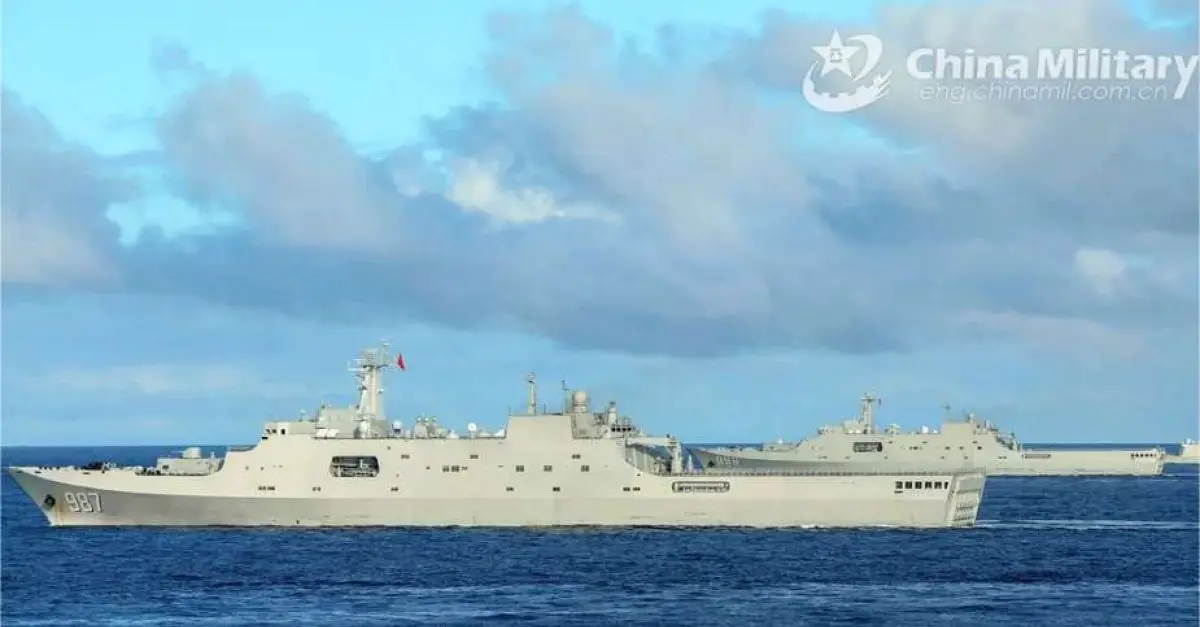Breaking News
Breaking News: Taiwan Armed Forces on High Alert Amid Chinese Missile Tests.
Taipei, Taiwan, July 13, 2024 — Taiwan's Ministry of National Defense has reported a significant increase in military activity by the People's Liberation Army (PLA) around the island. As of 6 a.m. (UTC+8) today, 30 PLA (Chinese Air Force) aircraft and 7 PLAN (Chinese Navy) vessels were detected operating in the vicinity of Taiwan. Notably, 20 of these aircraft crossed the median line and entered Taiwan's southwestern and southeastern Air Defense Identification Zones (ADIZ).
Follow Army Recognition on Google News at this link

Two amphibious landing ships from the Chinese People’s Liberation Army (PLA) Navy were recently observed in the waters off Taiwan's eastern coast. (Picture source: China MoD)
In a statement released via Twitter on July 13, 2024, the Ministry of National Defense emphasized that they have been closely monitoring the situation and have taken appropriate measures in response to these developments. The incursions come amidst heightened tensions in the region, raising concerns over regional stability and security.
On Saturday, July 13, 2024, Taiwan’s defense ministry also announced that it is closely monitoring a series of missile tests occurring in China’s far northern region of Inner Mongolia, with its air defense forces on high alert.
The ministry reported that starting from 4 a.m. (2000 GMT on Friday), it detected “multiple waves of test launches” conducted by China’s Rocket Force in Inner Mongolia, approximately 2,000 kilometers (1,200 miles) from Taiwan.
The tension between Taiwan and China stems from China's view of Taiwan as a breakaway province that it aims to reunify with the mainland, by force if necessary. Taiwan, on the other hand, is a democratically governed island with its own government and sees itself as a separate entity.
In recent years, tensions have escalated due to increased Chinese military activities near Taiwan, including frequent incursions by Chinese aircraft and naval vessels into Taiwan's air defense identification zone (ADIZ) and waters. This increased activity is seen as an attempt by China to intimidate Taiwan and signal its capability to enforce its territorial claims.
Recently, China's Navy has deployed more vessels near Taiwan, and the People's Liberation Army (PLA) conducted missile tests in Inner Mongolia. These missile tests and naval deployments are part of China's broader strategy to demonstrate its military might and readiness to act on its claims over Taiwan. Taiwan's defense ministry has been on high alert, monitoring these activities and preparing its air defense forces to respond to any potential threats. This situation underscores the ongoing and deepening military and political friction between Taiwan and China.
The tensions between China and Taiwan trace back to 1949, following the end of the Chinese Civil War. The Communist Party, led by Mao Zedong, established control over mainland China and formed the People's Republic of China (PRC). Meanwhile, the defeated Nationalist Party (Kuomintang), led by Chiang Kai-shek, retreated to Taiwan and set up a government-in-exile, continuing to assert itself as the legitimate government of all China.
In the 1950s and 1960s, there were occasional military skirmishes across the Taiwan Strait. The situation took a significant turn in 1971 when the United Nations recognized the PRC as the official representative of China, effectively excluding Taiwan from international recognition. During the 1980s, both sides saw limited interactions as China initiated economic reforms under Deng Xiaoping. China proposed the "One Country, Two Systems" policy, offering Taiwan a high degree of autonomy in exchange for reunification, which Taiwan declined.
The 1990s marked a critical period as Taiwan underwent democratization, highlighted by the election of its first native Taiwanese president, Lee Teng-hui, in 1996. This democratic shift was met with suspicion by Beijing. The Third Taiwan Strait Crisis erupted in 1995-1996 when China conducted missile tests and military exercises near Taiwan, aiming to dissuade what it perceived as growing pro-independence sentiments.
In the 2000s, tensions persisted, punctuated by diplomatic battles and military posturing. Taiwan's move towards further democratization and assertion of its identity continued to irk Beijing. China's economic rise and military modernization increased its leverage and assertiveness in the region.
In recent years, China's military activities around Taiwan have intensified, with frequent incursions by Chinese aircraft and naval vessels into Taiwan's air defense identification zone (ADIZ) and waters. This escalation is seen as part of China's broader strategy to pressure Taiwan into considering reunification under Beijing's terms. Recently, China has increased its naval deployments near Taiwan and conducted missile tests in Inner Mongolia, demonstrating its military capabilities and readiness. Taiwan's defense ministry has remained vigilant, closely monitoring these developments and preparing its air defense forces to respond to any potential threats. This ongoing military and political friction underscores the deep-seated and escalating tensions between China and Taiwan.


























